Congress is taking so long to start writing a new farm bill that the legislation won't be enacted until well into 2024, or even later, if the timelines for the four most recent farm bills are any guide.
If President Joe Biden were to sign a farm bill by the end of this September — when authorization for many of the programs in the 2018 farm bill is set to expire — Congress would have achieved in less than 80 days what has previously taken an average of about 18 months.
How Congress ultimately approaches the reauthorization of the 2018 farm bill is yet to be determined, but it's certainly not going to happen in 2023, based on how long the process has taken in the past.
“I don't know if I can compare [the current process] to anything else because I can't remember any of the farm bills that I've been involved with that we haven't done a markup in full committee — in either committee — before Labor Day,” Randy Russell, who has worked on farm bills as a congressional staffer, USDA official, and lobbyist over his four-decade-long tenure in farm policy, told Agri-Pulse.
The last time a farm bill was enacted into law in an odd-numbered year — the first year of a new Congress — was 1985. The last time the farm bill passed without an extension — or following the expiration of many of its authorized programs, as was the case with the 2018 law — was in 2002. The reauthorization process for the last four farm bills has averaged just over 550 days from start to finish; the shortest of those timelines was the 252-day process for the 2018 bill.
There’s also the elephant in the room — or donkey, depending on one’s political persuasion — of the upcoming election and its potential to change the control of the House, Senate and White House. Since the enactment of the 1990 farm bill, the legislation has become law an average of about 240 days before Election Day, with only the 1990 and 2018 reauthorizations standing as exceptions.
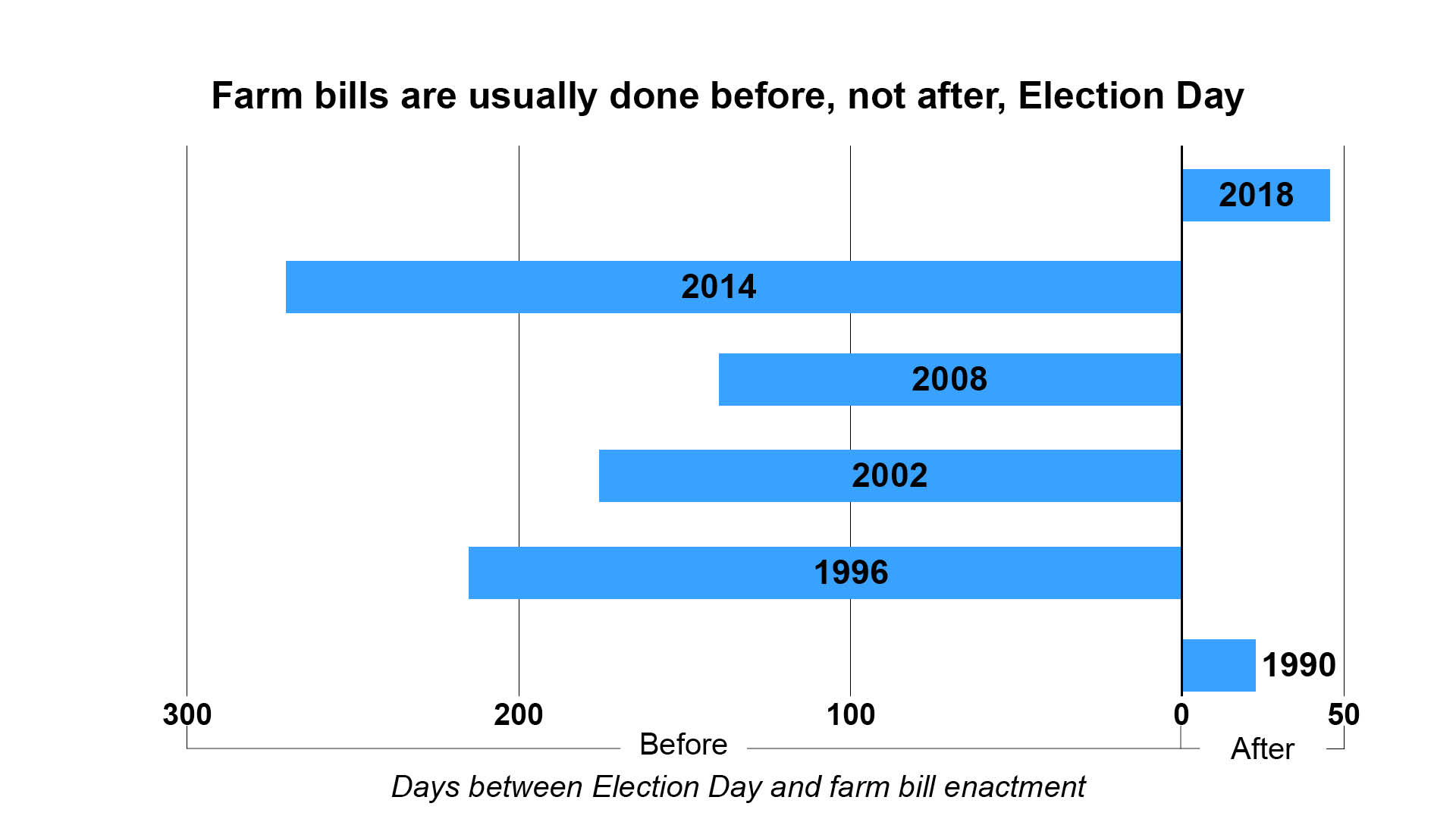
Tom Buis — who counts Growth Energy, National Farmers Union, and then-Senate Majority Leader Tom Daschle, D-S.D., among his stops on the farm policy trail — said election-year politics can offer an impetus for lawmakers to deliver.
“Elected politicians don't like to go home and be criticized for not taking care of their constituents,” he said. “Everybody's going to be saying, ‘How come you're not passing a farm bill?’ That tends to force people's hand to want to get together and move on.”
Agri-Pulse studied the timelines of each farm bill passed since the turn of the century to catalog the major milestones — the markups, votes, and other key public-facing events that moved the process along. The full process of writing a farm bill also includes lengthy stretches of time to gather feedback and ideas before lawmakers begin their work on the next bill and implementation of the bill at USDA once enacted.
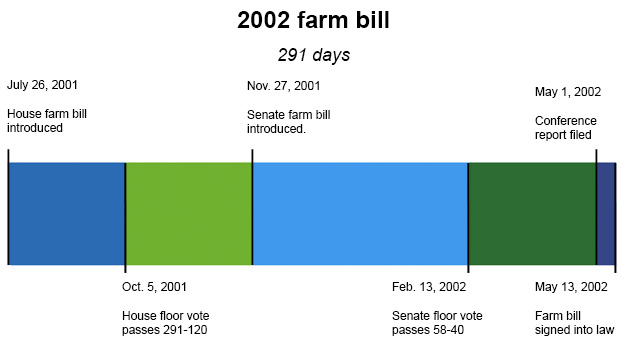
2002 — 291 days
The 2002 farm bill was Capitol Hill’s first crack at reauthorization since the 1996 law, which ushered in the “freedom to farm” concept of ag policy, ending many of the supply management concepts that had been staples of American agriculture.
To hear Buis tell it, Congress had work to do.
“Almost every year — I'm pretty sure every year — Congress had to find supplemental funding to make up for the shortfall of 'freedom to farm' and finally when they got the opportunity, they changed it because it wasn't sufficient to meet the challenges of rural America at that time,” he said. “We went through year after year of what they called disaster-related funding to address the shortfalls.”
Lawmakers kept the fixed, direct payments authorized by the 1996 law but introduced countercyclical payments, using some of an additional $73.5 billion in new spending provided for the bill.
“Taking nothing away from those involved … it's a hell of a lot easier to write a farm bill when you're given money above the baseline,” Russell said.
But why the massive funding increase?
In addition to a response to the 1996 bill, many point to the upcoming midterm elections and President George W. Bush's push to win majority control of the Senate in the 2002 midterm elections (the GOP would go on to eke out a 51-49 majority). With a budget surplus to spend, lawmakers also looked to gin up support in key constituencies.
The legislation was also passed under the shadow of the Sept. 11, 2001, terrorist attacks, which introduced a fresh focus on national security in all areas of policy, including the farm bill.
A USDA summary of the 2002 farm bill notes the inclusion of bioterrorism measures such as funding for “activities related to reducing the vulnerability of the U.S. food and agricultural system to chemical and biological attack” and a grant program “to expand and upgrade security at agricultural research facilities.”
Aside from the security provisions and funding boost, the bill was also noteworthy for its expansion of country-of-origin labeling that would go on to produce a World Trade Organization spat with Canada and Mexico, the first energy title in the bill’s history, and a conservation policy spat that nearly sank the bill.
Sen. Tom Harkin, the Iowa Democrat who chaired the Senate Ag Committee, introduced the Conservation Security Program — later renamed the Conservation Stewardship Program — in the 2002 farm bill, but was pushing for even broader changes as the House and Senate met in conference. According to an interview with Rep. Charlie Stenholm, the Texas Democrat who was the ranking member of the House Ag Committee at the time, Harkin and then-House Ag Chair Larry Combest, R-Texas, were so far apart in their discussions that House negotiators eventually walked out on the talks.
“And as we're walking back through the tunnel, Larry says, ‘I hope the heck this works.’ And I said ‘Me too,’” Stenholm recalled in a 2022 interview with the House Ag Committee.
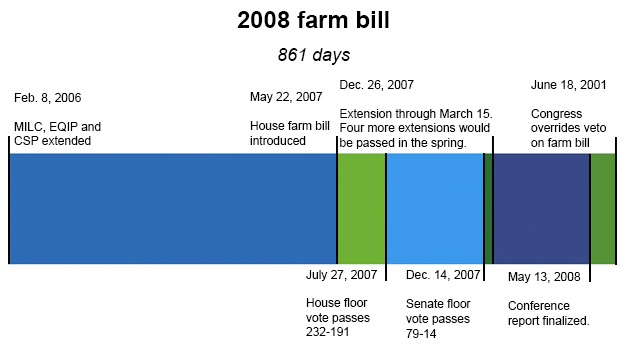
2008 — 861 days
The timeline for the 2008 farm bill started — according to the Congressional Research Service — in 2006, when an extension of some dairy and conservation provisions kicked off the legislative activity.
It would be more than a year before the House Ag Committee introduced its legislation, a 468-day pause that marks the biggest gap in activity on any of the farm bill timelines. Once that bill dropped on May 22, 2007, it would be another 393 days before the farm bill was ultimately the law of the land, a process that included several more extensions and a staring match between the White House and Capitol Hill that ultimately led to this being the only farm bill since the turn of the century never to earn a presidential signature.
With 15 titles, the bill was five chapters longer than its 2002 counterpart after adding specific titles on horticulture and organic agriculture, livestock, crop insurance and disaster assistance, reauthorization of the Commodity Futures Trading Commission, and trade and tax provisions.
Included in those new titles and throughout the rest of the bill were several tweaks to the 2002 farm bill and a handful of new creations. Some of the language in the livestock title — namely the expansion of country-of-origin labeling and changes to competition language in the sector — still reverberate in modern farm policy as USDA seeks to fine-tune the competition language and chart a path toward a voluntary, but more restrictive, “product of the USA” label on meat products.
The 2008 farm bill was also the first piece of legislation to refer to the food stamp program as the Supplemental Nutrition Assistance Program. It was also the first farm bill with a specific crop insurance title and worked toward a permanent disaster structure of a $3.8 billion trust fund “to cover the cost of making agricultural disaster assistance available on an ongoing basis” in the years that followed the bill’s enactment, according to the Congressional Research Service.
But the 2008 farm bill might be remembered as much for the process it took to pass it than for the policies it enacted.
In all, the 2008 farm bill process involved six extensions and two vetoes.
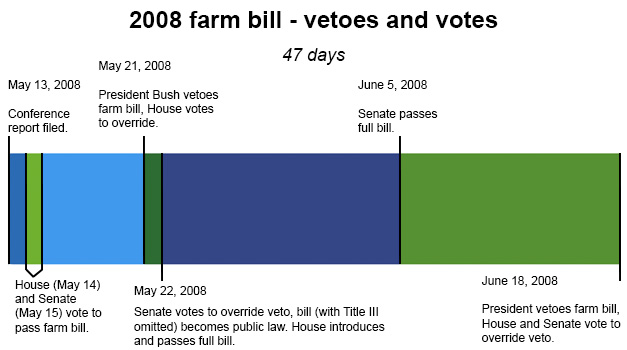
President George W. Bush vetoed the farm bill for the first time on May 21, 2008, largely due to his objections to the newly-created Average Crop Revenue Election, a program that, as Agri-Pulse reported in its 2017 series detailing the history of farm bills, was never as popular or costly as Bush feared would be the case.
“At a time of high food prices and record farm income, this bill lacks program reform and fiscal discipline,” Bush noted in his veto message. “It continues subsidies for the wealthy and increases farm bill spending by more than $20 billion, while using budget gimmicks to hide much of the increase.”
Bush asked Congress to extend the 2002 farm bill for another year or more; instead, Congress voted to override his veto by sweeping margins in both chambers.
But in an unprecedented filing error, the trade title was erroneously left out of the farm bill that had been submitted to the White House.
On May 22, 2008, the Senate followed the House in voting to override President Bush’s veto of H.R. 2419, the bill lacking the trade title. The same day, the House passed H.R. 6124, the completed bill with all 15 titles. The Senate would follow suit two weeks later on June 5, 2008.
The House and Senate’s speedy action to move the full farm bill set the stage for President Bush’s subsequent June 18, 2008, veto of the full farm bill, an action that was overridden in the House and Senate on the same day.
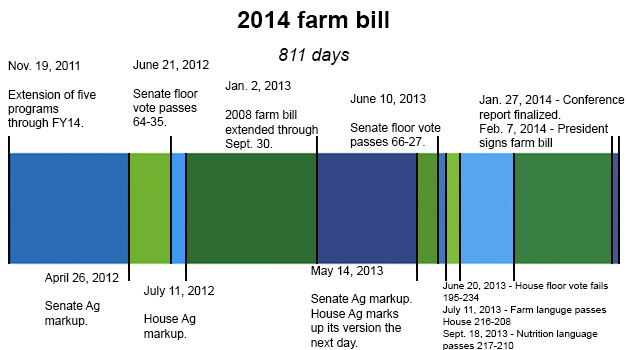
2014 — 811 days
The 2014 farm bill introduced an unthinkable reality on the floor of the House of Representatives — the splitting of the farm and food coalition that had been vital to the passage of every other farm bill to date.
The break was not permanent, but it was a sign of things to come for future farm policy efforts when House conservatives flexed their muscle in a floor vote frustrating agricultural policy champions and embarrassing the GOP leadership of the chamber.
The process that led to that inflection point began in 2011, when a “Super Committee” met throughout the year seeking to slash the federal deficit by at least $1.5 trillion. An archived explainer from the Obama White House made it clear “everything” was on the table in search of savings.
The committee, the White House said at the time, “can eliminate tax loopholes, just like it can cut spending.” Half the cuts were to come from domestic spending programs, the other half from defense spending.
When the cadre of Capitol Hill negotiators and the Obama administration were unable to come up with a deal, a provision in the Budget Control Act introduced automatic spending cuts known as “sequestration” took effect. But during the process, House and Senate Ag Committee leaders ultimately agreed on a legislative framework that included about $23 billion in planned savings through the elimination of direct payments to producers and cuts in nutrition and conservation programs.
In the wake of a perplexing process, the 2014 farm bill instituted some landmark changes in the nation’s farm policy. Among them was the creation of the Agriculture Risk Coverage and Price Loss Coverage programs, which reshaped the farm bill’s commodity title after the elimination of direct payments. The bill also instituted caps on Conservation Reserve Program acreage and shrank the number of titles down to 12.
But in addition to the fingerprints of the Super Committee and the introduction of ARC and PLC acronyms into the farm policy vernacular, the 2014 farm bill is perhaps best known for the political acrimony that had to be overcome on the way to final passage.
It was in 2011 that Congress began its legislative activity on what would become the 2014 farm bill when it voted in November to extend five conservation programs in the 2008 farm bill through the 2014 fiscal year.
With many parts of the 2008 farm bill set to expire in 2012, the Senate acted in April of that year to mark up a bill in committee, a measure that ultimately cleared the Senate floor on June 21, 2012. The House Ag Committee would convene a few weeks later, marking up a bill on July 11, 2012, that would never go on to see floor action.
In 2013, Congress ushered in a new session with a Jan. 2 extension of the 2008 farm bill through the end of that September, but did so without funding programs that lacked mandatory baseline.
The Senate once again started the legislative process, marking up a farm bill on May 14, 2013; the House Ag Committee would match the progress in a marathon session the next day. The Senate was then able to advance its measure in a June 10, 2013, vote, only for the process to hit a massive speed bump 10 days later.
Members of the House Freedom Caucus were able to insert an amendment from then-Rep. Steve Southerland, R-Fla., to allow states to institute their own work requirements for SNAP recipients.
“After we finally got everything together, (then-House Majority Leader Eric) Cantor and Sutherland came in and monkeyed with the agreement that we had and took the bill down, and that cost us another seven months,” Minnesota Democrat Collin Peterson, then the committee’s ranking member, told Agri-Pulse in 2014.
Democrats revolted, and the farm bill went down 195-234 on the House floor, a previously unthinkable fate for what had traditionally been a fairly bipartisan bill.
Russell classified the 2013 floor breakdown as an example of “fundamental” mistakes in not managing the bill across the House floor by the chamber's GOP leadership.
“I have never in all my years seen a major reauthorization bill — I'm not talking about in ag, I'm talking about any major reauthorization bill — when you get done dealing with all the amendments, and you go to our final passage and it fails. Never seen that,” he said. “Normally, they'll just pull the bill, right?”
“Once the Southerland amendment passed, they should have pulled the bill, and they didn't,” Russell added. “And I think Chairman [Frank] Lucas, to his credit, went to them and tried to get them to pull it, and they didn't do it.”
Forced to move something to get the measure to conference, House GOP leaders put the farm bill without the nutrition title on the floor for a July 11, 2013 vote, temporarily breaking the urban and rural farm bill alliance. The bill’s nutrition language would eventually be passed in September, paving the way for the beginning of a conference process and a bill that would eventually be signed by President Barack Obama on Feb. 7, 2014.
“I kiddingly tell people back home that it was just short of a miracle,” Lucas, the Oklahoma Republican who chaired House Ag at the time, told Agri-Pulse later that year. “And what do I mean by that? A true miracle implies divine intervention. This wasn't quite that, but it was real close.”
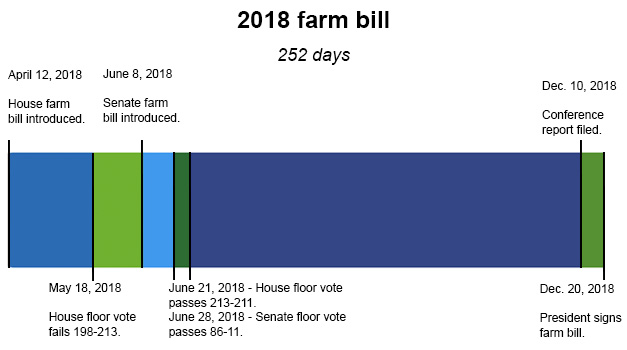
2018 — 252 days
The most recent farm bill was also the quickest piece of legislation to cross the finish line in the 2000s and the only version to start and end its process in the same calendar year, something that was commonplace for the bills passed prior to the 1996 law.
But the bill’s path to President Donald Trump’s desk was anything but smooth.
The bill’s principal issue — a stalemate over a House GOP plan to change work rules for able-bodied adults without dependents — was evident even before the bill was introduced on April 12, 2018. Just shy of a month earlier, then-House Ag Committee Chair Mike Conaway held off on introducing the bill as he and Peterson, still the committee’s ranking member, worked on an agreement. But the committee’s Democrats implored Peterson to hold off on negotiating the farm bill without seeing the draft legislative text from Conaway.
Absent further negotiations between the two House Ag leaders, Conaway opted to move ahead with bill introduction and a committee markup on April 18, 2018. At that meeting, Conaway said he “sought in good faith to work with the ranking member of the development of this farm bill … I sincerely regret that our discussions ultimately did not bear fruit with respect to the nutrition title,” noting some “honest disagreements that apparently prevented us from coming together on a farm bill.”
A typically stoic Peterson let some emotion show in his opening statement as he said the process of drafting the bill was “turning friends into enemies.”
“I didn't walk away — we didn't walk away — we were pushed away by an ideological fight I repeatedly warned the chairman not to start,” he said.
Despite the partisan rancor throughout the markup, the bill advanced through committee and headed to the floor, where it ran into another conservative roadblock. An immigration policy rebellion within the Republican Party denied Conaway the votes necessary to pass the farm bill, sinking the measure on the House floor for the second time in as many reauthorization efforts.
The dispute would eventually be set aside as House Republicans eked out a two-vote margin to move the bill on the floor with no Democratic support; after 30 Republicans voted against the farm bill during the first floor vote, 20 kept their opposition in a June 21 vote.
Don’t miss a beat! It’s easy to sign up for a FREE month of Agri-Pulse news! For the latest on what’s happening in Washington, D.C. and around the country in agriculture, just click here.
The process was much less dramatic in the Senate, where a bill with a more moderate nutrition title advanced quickly through the Senate Ag Committee in a June 13 markup and June 28 floor vote with 86 senators backing the legislation.
The conference process for the bill needed to resolve not only the partisan impasse over nutrition policy, but also differences in the commodity title and whether or not to include an energy title (the Senate bill maintained it, the House’s did not).
The bill was also being written against the backdrop of sliding commodity prices and an ongoing trade war with China that had wreaked havoc on once-reliable purchasing relationships for U.S. commodities.
One month after a public conference committee meeting featuring a repeat of many of the same SNAP arguments previously offered in the House, the four lead negotiators — Conaway and Peterson from the House and then-Senate Ag Chair Pat Roberts, R-Kan., and ranking member Debbie Stabenow, D-Mich. — made a show of emerging from a Capitol Hill meeting locked arm-in-arm and declaring they were “in this together.”
That meeting took place on Oct. 4, 2018, days after much of the 2014 farm bill had expired and about four-and-a-half weeks before Democrats would reclaim the House. The change in political dynamics offered negotiators a binary choice: start over on a new farm bill with a new party in control of one of the chambers of Congress or finish the legislation in the lame-duck session. They opted for the latter.
“I think the idea is that we were going to get to a yes, at some point,” Conaway told Agri-Pulse in a 2018 interview. “So you negotiate as hard as you can throughout that entire process, but the change in the election, the House swapping sides in early November, added a little emphasis to it.”
The four leaders announced a tentative agreement Nov. 28 and filed it as legislative text Dec. 10. The bill quickly moved across the Senate floor the next day and was voted favorably out of the House the day after that, clearing the way for a Dec. 20 White House signing ceremony that was kicked off by the blasting of the “Green Acres” theme song, bewildering but amusing a crowd of onlookers waiting for the delayed start of Trump’s speech.
The final product ultimately did not include many of the nutrition policy reforms Conaway had championed, but many Republicans on Capitol Hill ultimately supported the bill as then-Ag Secretary Sonny Perdue pointed to rulemaking in the works at the department that could have similar results (the Biden administration would later reverse course). The bill also lacked some forestry provisions pursued by Conaway and Perdue, but did write into law a hemp program championed by then-Senate Majority Leader Mitch McConnell.
The bill’s commodity title included some modest reforms, including the ability for producers to switch between ARC and PLC more easily. The bill also cleaned up a dairy policy change resulting from a dispute with the CBO during the 2014 farm bill process — changing the margin calculation and rebranding the industry’s risk management program as Dairy Margin Coverage — and created the National Animal Vaccine and Veterinary Countermeasures Bank, a major priority for the livestock industry headed into the bill.
“You had to come to some agreement … so we could provide that certainty and predictability,” Roberts told Agri-Pulse in a 2018 interview. “This was not a revolutionary farm bill; it was evolutionary on purpose.”
For more news, go to www.Agri-Pulse.com.


